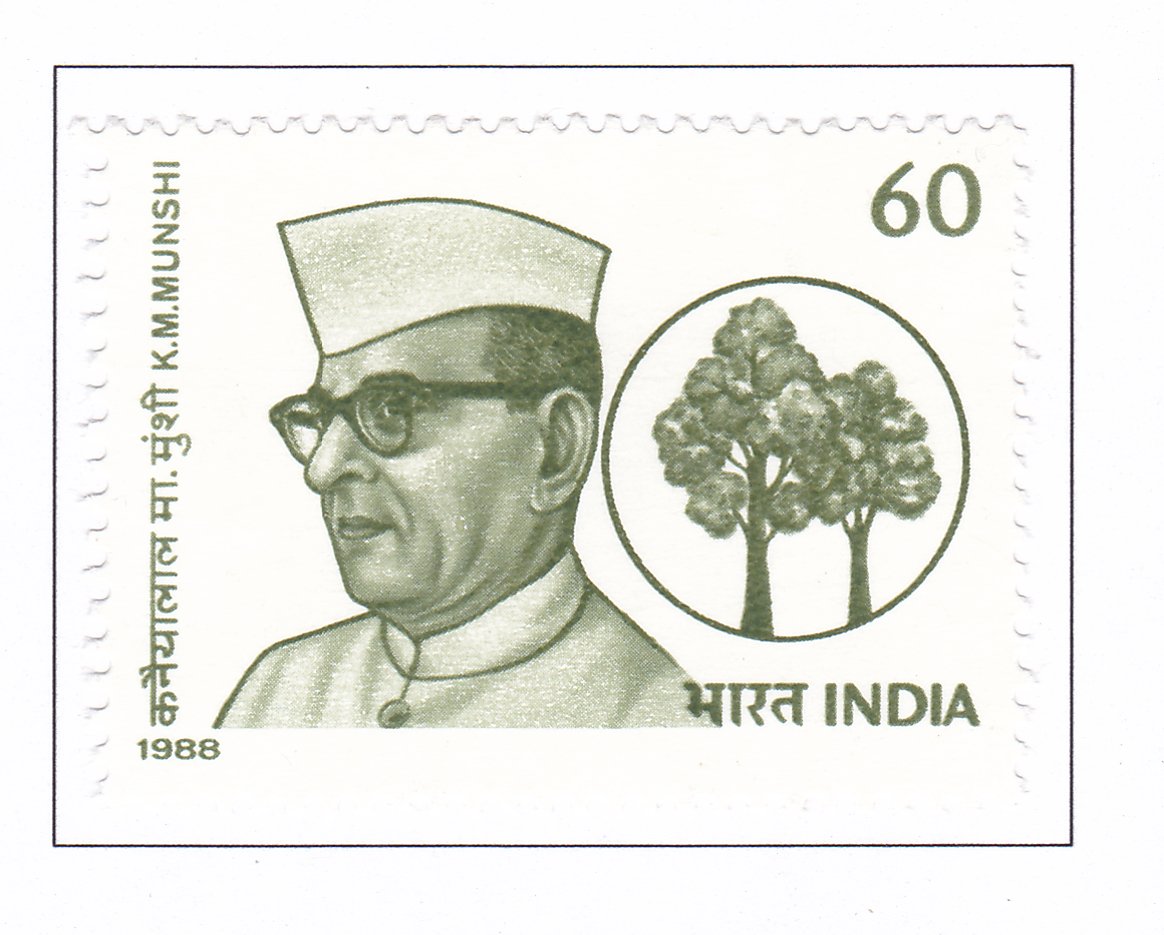Kanaiyalal Maneklal Munshi

Technical Data
| Stamp Set | Birth Centenary |
|---|---|
| Date of Issue | December 30, 1988 |
| Denomination | 60 p |
| Quantity | 1,000,000 |
| Perforation | comb 13½ x 13 |
| Printer | Security Printing Press, Nashik |
| Watermark | No Watermark |
| Colors | Deep olive |
| Catalog Codes |
Michel IN 1197 Stamp Number IN 1255 Yvert et Tellier IN 1004 Stanley Gibbons IN 1343 |
| Themes | Anniversaries and Jubilees | Authors | Famous people | Headgear | Literary People (Poets and Writers) | Literature | Optical Instruments | Politicians |
K.M. Munshi: A Multifaceted Luminary
Introduction:
Kanaiyalal Maneklal Munshi, remembered for his versatility, was a freedom-fighter, lawyer, one of the makers of India’s Constitution, literary giant, philosopher, creative artist, educationalist, promoter of art, music, dance, and drama, an able administrator, an advocate of Sanskrit and Hindi, environmentalist, and a builder of institutions.
Early Life:
- Birth: Born on 30th December 1887 in Broach (now in Gujarat State).
- Education: Settled in Bombay in 1901; influenced by Shri Aurobindo Ghosh at Baroda College.
- Marriage: Married Atilaxmi Pathak at 14.
Legal Career:
- Advocate: Enrolled as an advocate (O.S.) in 1913.
- Home Rule League: Joined and became Joint Editor of Young India.
- Indian National Congress: Became a member of the Subjects Committee in 1917.
Educational Contributions:
- Panchgani Education Society: Elected President.
- Gujarati Sahitya Sansad: Founded the institution.
- Bombay University: Associated in different capacities.
- Baroda University Commission: Appointed by Maharaja Gaekwad of Baroda.
Personal Life:
- First Wife: Atilaxmi passed away in February 1924.
- Second Marriage: Married Lilavati Seth in 1926.
Political Career:
- Bombay Legislative Council: Elected in 1927; resigned in 1929 during Bardoli Satyagraha; re-elected in 1930.
- Imprisonments:
- Six months for participating in the Salt Satyagraha movement in 1930.
- Two years’ rigorous imprisonment in Bijapur in 1932.
- Bombay Legislative Assembly: Re-elected in 1934; appointed Home Minister in the first Congress Government.
- Gujarati Sahitya Parishad: Elected President.
- Satyagraha Movement: Resigned Home Ministership in 1939; arrested again.
- Constitution Drafting: Appointed to the Experts’ Committee in 1946; elected to the Constituent Assembly.
- Hyderabad: Appointed Agent-General to the Government of India in 1947.
- Union Minister: Became Union Minister for Food & Agriculture in 1950.
- Governor of Uttar Pradesh: Served from 1952-57.
- Swatantra Party: Resigned from Congress in 1959; elected Vice-President.
Bhartiya Vidya Bhavan:
- Founding: Established in 1938 in Bombay.
- Leadership: Guided as President till his death.
- Expansion: Transformed into a major institution with over 85 constituent institutions and 50 Kendras.
Literary Contributions:
- Promoter: Promoted a monthly magazine, BHARGAVA.
- Prolific Writer: Authored over 125 books including social, mythological, and historical novels in English, Hindi, and Gujarati.
- Notable Works:
- “Mari Kamala”
- “Varni Vasulat”
- “Kono-Vank”
- “Patan-ni-Prabhuta”
- “Gujarat-no-Nath”
- “Prithvi Vallabh”
- “Rajadhi Raj”
- “Kakani Shashi”
- “Gujarat & Its Literature”
- “I Follow the Mahatma”
- “Akhand Hindustan”
- “The Glory that was Gurjaradesa”
- “Imperial Gurjars”
- “Bhagvadgita & Modern Life”
- “Gandhi the Master”
- “The End of an Era”
- “Krishnavatara”
Legacy:
- Architect of Modern India: Remembered among the great architects and builders of modern India.
- Death: Passed away on 8th February 1971.
K.M. Munshi’s life and work continue to inspire future generations with his contributions to India’s freedom struggle, legal system, education, literature, and cultural heritage.
